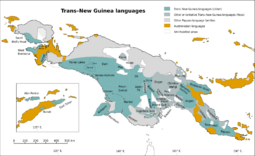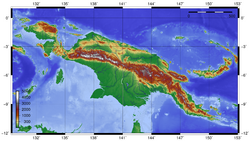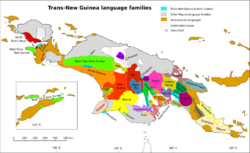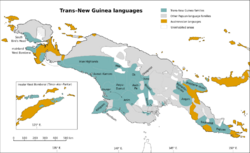Trans–New Guinea languages
Topic: Social
 From HandWiki - Reading time: 19 min
From HandWiki - Reading time: 19 min
| Trans–New Guinea | |
|---|---|
| Geographic distribution | New Guinea, East Timor, East Nusa Tenggara (Alor, Pantar) |
| Linguistic classification | One of the world's primary language families |
| Proto-language | Proto-Trans–New Guinea |
| Subdivisions |
|
| ISO 639-5 | ngf |
| Glottolog | None nucl1709 (Nuclear Trans–New Guinea, partial overlap)[1] |
 The extent of various proposals for Trans–New Guinea.
Families accepted by Usher[2]
Other families proposed by Ross (2005)
Other Papuan languages
Austronesian languages
Uninhabited | |
Trans–New Guinea (TNG) is an extensive family of Papuan languages spoken on the island of New Guinea and neighboring islands, a region corresponding to the country Papua New Guinea as well as parts of Indonesia.
Trans–New Guinea is perhaps the third-largest language family in the world by number of languages. The core of the family is considered to be established, but its boundaries and overall membership are uncertain. The languages are spoken by around 3 million people.[3] There have been several main proposals as to its internal classification.
History of the proposal
Although Papuan languages for the most part are poorly documented, several of the branches of Trans–New Guinea have been recognized for some time. The Eleman languages were first proposed by S. Ray in 1907, parts of Marind were recognized by Ray and JHP Murray in 1918, and the Rai Coast languages in 1919, again by Ray.
The precursor of the Trans–New Guinea family was Stephen Wurm's 1960 proposal of an East New Guinea Highlands family. Although broken up by Malcolm Ross in 2005, it united different branches of what became TNG for the first time, linking Engan, Chimbu–Wahgi, Goroka, and Kainantu. (Duna and Kalam were added in 1971.) Then in 1970, Clemens Voorhoeve and Kenneth McElhanon noted 91 lexical resemblances between the Central and South New Guinea (CSNG) and Finisterre–Huon families, which they had respectively established a few years earlier. Although they did not work out regular sound correspondences, and so could not distinguish between cognates due to genealogical relationship, cognates due to borrowing, and chance resemblances, their research was taken seriously. They chose the name Trans–New Guinea because this new family was the first to span New Guinea, from the Bomberai Peninsula of western West Irian to the Huon Peninsula of eastern PNG. They also noted possible cognates in other families Wurm would later add to TNG: Wurm's East New Guinea Highlands, Binandere in the 'Bird's Tail' of PNG, and two families that John Z'graggen would later (1971, 1975) unite in his 100-language Madang–Adelbert Range family.
In 1975, Wurm accepted Voorhoeve and McElhanon's suspicions about further connections, as well as Z'graggen's work, and postulated additional links to, among others, the languages of the island of Timor to the west of New Guinea, Angan, Goilalan, Koiarian, Dagan, Eleman, Wissel Lakes, the erstwhile Dani-Kwerba family, and the erstwhile Trans-Fly–Bulaka River family (which he had established in 1970), expanding TNG into an enormous language phylum that covered most of the island of New Guinea, as well as Timor and neighboring islands, and included over 500 languages spoken by some 2,300,000 people. However, part of the evidence for this was typological, and Wurm stated that he did not expect it to stand up well to scrutiny. Although he based the phylum on characteristic personal pronouns, several of the branches had no pronouns in common with the rest of the family, or even had pronouns related to non-TNG families, but were included because they were grammatically similar to TNG. Other families that had typical TNG pronouns were excluded because they did not resemble other TNG families in their grammatical structure.
Because grammatical typology is readily borrowed—many of the Austronesian languages in New Guinea have grammatical structures similar to their Papuan neighbors, for example, and conversely many Papuan languages resemble typical Austronesian languages typologically—other linguists were skeptical. William A. Foley rejected Wurm's and even some of Voorhoeve's results, and he broke much of TNG into its constituent parts: several dozen small but clearly valid families, plus a number of apparent isolates.
In 2005, Malcolm Ross published a draft proposal re-evaluating Trans–New Guinea, and found what he believed to be overwhelming evidence for a reduced version of the phylum, based solely on lexical resemblances, which retained as much as 85% of Wurm's hypothesis, though some of it tentatively.
The strongest lexical evidence for any language family is shared morphological paradigms, especially highly irregular or suppletive paradigms with bound morphology, because these are extremely resistant to borrowing. For example, if the only recorded German words were gut "good" and besser "better", that alone would be enough to demonstrate that in all probability German was related to English. However, because of the great morphological complexity of many Papuan languages, and the poor state of documentation of nearly all, in New Guinea this approach is essentially restricted to comparing pronouns. Ross reconstructed pronouns sets for Foley's basic families and compared these reconstructions, rather than using a direct mass comparison of all Papuan languages; attempted to then reconstruct the ancestral pronouns of the proto-Trans–New Guinea language, such as *ni "we", *ŋgi "you", *i "they"; and then compared poorly supported branches directly to this reconstruction. Families required two apparent cognates to be included. However, if any language in a family was a match, the family was considered a match, greatly increasing the likelihood of coincidental resemblances, and because the plural forms are related to the singular forms, a match of 1sg and 1pl, although satisfying Ross's requirement of two matches, is not actually two independent matches, again increasing the likelihood of spurious matches. In addition, Ross counted forms like *a as a match to 2sg *ga, so that /ɡV, kV, ŋɡV, V/ all counted as matches to *ga. And although /n/ and /ɡ/ occur in Papuan pronouns at twice the level expected by their occurrence in pronouns elsewhere in the world, they do not correlate with each other as they would if they reflected a language family. That is, it is argued that Ross's pronouns do not support the validity of Trans–New Guinea, and do not reveal which families might belong to it.[4]
Ross also included in his proposal several better-attested families for non-pronominal evidence, despite a lack of pronouns common to other branches of TNG, and he suggested that there may be other families that would have been included if they had been better attested. Several additional families are only tentatively linked to TNG. Because the boundaries of Ross's proposal are based primarily on a single parameter, the pronouns, all internal structure remains tentative.
The languages

Most TNG languages are spoken by only a few thousand people, with only seven (Melpa, Kuman, Enga, Huli, Western Dani, Makasae, and Ekari) being spoken by more than 100,000.[5] The most populous language outside of mainland New Guinea is Makasae of East Timor, with 100,000 speakers throughout the eastern part of the country. Enga is the most populous Trans-New Guinea language spoken in New Guinea, with more than 200,000 speakers. Golin, Sinasina, Mid Grand Valley Dani, Kamano, and Bunaq have between 50,000 and 100,000 speakers (Galela of Halmahera, usually not classified as Trans-New Guinea, also has between 50,000 and 100,000 speakers.) All other Trans–New Guinea languages have fewer than 50,000 speakers.[5]
The greatest linguistic diversity in Ross's Trans–New Guinea proposal, and therefore perhaps the location of the proto-Trans–New Guinea homeland, is in the interior highlands of Papua New Guinea, in the central-to-eastern New Guinea cordillera where Wurm first posited his East New Guinea Highlands family. Indonesian Papua and the Papuan Peninsula of Papua New Guinea (the "bird's tail") have fewer and more widely extended branches of TNG, and were therefore likely settled by TNG speakers after the proto-language broke up.
Ross speculates that the TNG family may have spread with the high population densities that resulted from the domestication of taro, settling quickly in the highland valleys along the length of the cordillera but spreading much more slowly into the malarial lowlands, and not at all into areas such as the Sepik River valley where the people already had yam agriculture, which thus supported high population densities. Ross suggests that TNG may have arrived at its western limit, the islands near Timor, perhaps four to 4.5 thousand years ago, before the expansion of Austronesian into this area. Roger Blench associates the spread of Trans–New Guinea languages with the domestication of the banana.[6]
Classification
Wurm (1975)
The classification here follows Wurm and includes some later modifications to his 1975 proposal.[7] Wurm identifies the subdivisions of his Papuan classification as families (on the order of relatedness of the Germanic languages), stocks (on the order of the Indo-European languages), and phyla (on the order of the Nostratic hypothesis). Trans-New Guinea is a phylum in this terminology. A language that is not related to any other at a family level or below is called an isolate in this scheme.
Trans-New Guinea phylum (Wurm 1975)
|
|---|
|
('Family-level' groups are listed in boldface)
|
Foley (2003)
As of 2003, William A. Foley accepted the core of TNG: "The fact, for example, that a great swath of languages in New Guinea from the Huon Peninsula to the highlands of Irian Jaya mark the object of a transitive verb with a set of verbal prefixes, a first person singular in /n/ and second person singular in a velar stop, is overwhelming evidence that these languages are all genetically related; the likelihood of such a system being borrowed vanishingly small."[8] He considered the relationship between the Finisterre–Huon, Eastern Highlands (Kainantu–Gorokan), and Irian Highlands (Dani – Paniai Lakes) families (and presumably some other smaller ones) to be established, and he said that it is "highly likely" that the Madang family belongs as well. He considered it possible, but not yet demonstrated, that the Enga, Chimbu, Binandere, Angan, Ok, Awyu, Asmat (perhaps closest to Ok and Awyu), Mek, Sentani, and the seven small language families of the tail of Papua New Guinea (Koiarian, Goilalan, etc., which he maintains have not been shown to be closely related to each other) may belong to TNG as well.
Ross (2005)

| Irian Jaya, W to E South Bird's Head West Trans–New Guinea Kaure–Kapori Pauwasi Mek Asmat–Kamoro Awyu–Dumut Ok Kayagar Marind Kolopom | PNG highlands, W to E Awin–Pa East Strickland Duna Bosavi Engan West Kutubuan East Kutubuan Chimbu–Wahgi Kainantu–Goroka Madang Finisterre–Huon | Southern PNG, E to W Binanderean Southeast Papuan Angan Eleman Teberan Turama–Kikorian Kiwai–Porome Inland Gulf Gogodala–Suki Tirio isolates* |
Ross does not use specialized terms for different levels of classification as Donald Laycock and Stephen Wurm did. In the list given here, the uncontroversial families that are accepted by Foley and other Papuanists and that are the building blocks of Ross's TNG are printed in boldface. Language isolates are printed in italics.
Ross removed about 100 languages from Wurm's proposal, and only tentatively retained a few dozen more, but in one instance he added a language, the isolate Porome.
Ross did not have sufficient evidence to classify all Papuan groups. In addition, the classification is based on a single feature – shared pronouns, especially 1sg and 2sg – and thus is subject to false positives as well as to missing branches that have undergone significant sound changes, since he does not have the data to establish regular sound correspondences.
- Unclassified Wurmian languages
Although Ross based his classification on pronoun systems, many languages in New Guinea are too poorly documented for even this to work. Thus there are several isolates that were placed in TNG by Wurm but that cannot be addressed by Ross's classification. A few of them (Komyandaret, Samarokena, and maybe Kenati) have since been assigned to existing branches (or ex-branches) of TNG, whereas others (Massep, Momuna) continue to defy classification.
- Kenati (→ Kainantu?)
- Komyandaret (→ Greater Awyu)
- Massep isolate
- Molof isolate
- Momuna family (2)
- Samarokena (→ Kwerba)
- Tofamna isolate
- Usku isolate
- Reclassified Wurmian languages
Ross removed 95 languages from TNG. These are small families with no pronouns in common with TNG languages, but that are typologically similar, perhaps due to long periods of contact with TNG languages.
- Border and Morwap (Elseng), as an independent Border family (15 languages)
- Isirawa (Saberi), as a language isolate (though classified as Kwerba by Clouse, Donohue & Ma 2002)[9]
- Lakes Plain, as an independent Lakes Plain family (19)
- Mairasi, as an independent Mairasi family (4)
- Nimboran, as an independent Nimboran family (5)
- Piawi, as an independent Piawi family (2)
- Senagi, as an independent Senagi family (2)
- Sentani (4 languages), within an East Bird's Head – Sentani family
- Tor and Kwerba, joined as a Tor–Kwerba family (17)
- Trans-Fly – Bulaka River is broken into five groups: three remaining (tentatively) in TNG (Kiwaian, Moraori, Tirio), plus the independent South-Central Papuan and Eastern Trans-Fly families (22 and 4 languages).
Trans–New Guinea phylum (Ross 2005)
|
|---|
|
Pawley and Hammarström (2018)
Andrew Pawley and Harald Hammarström (2018) accept 35 subgroups as members of Trans-New Guinea.[10][5]
Trans–New Guinea phylum (Pawley and Hammarström 2018)
| ||
|---|---|---|
|
Groups and isolates considered by Pawley and Hammarström (2018) as having weaker or disputed claims to membership in Trans-New Guinea (some of which they suggest may ultimately turn out to be Trans-New Guinea, but further evidence is needed):[10]
- Bayono-Awbono (2)
- Komolom (Mombum) (2)
- Mairasi (3)
- Pauwasi (5)
- Pawaian (isolate)
- Sentanic (4)
- South Bird's Head (12)
- Tanah Merah (isolate)
- Teberan (2)
- Timor-Alor-Pantar (20+)
- Uhunduni (Damal) (isolate)
Groups and isolates sometimes classified as Trans-New Guinea, but rejected by Pawley and Hammarström (2018) as Trans-New Guinea:[10]
- Dem (isolate)
- Eleman (5)
- Kaki Ae (isolate)
- Kamula (isolate)
- Kaure-Narau (2)
- Mor (isolate)
- Porome (isolate)
- Purari (isolate)
Glottolog 4.0 (2019)
Glottolog 4.0 (2019), of which Hammarström is one of the editors, accepts 10 groups as part of the Nuclear Trans–New Guinea family.[11]
- Madang (106)
- Finisterre-Huon (61)
- Asmat-Awyu-Ok (49)
- Kainantu-Goroka (28)
- Chimbu-Wahgi (17)
- Enga-Kewa-Huli (14)
- Dani (13)
- Greater Binanderean (13)
- Mek (8)
- Paniai Lakes (5)
Usher (2020)
Timothy Usher has reconstructed lower-level constituents of Trans–New Guinea to verify, through the establishment of regular sound changes, which purported members truly belong to it, and to determine their subclassification. In many cases Usher has created new names for the member families to reflect their geographic location. Much of his classification is accepted by Glottolog (though his names are not, as Glottolog invents its own names). As of 2020, his classification is as follows, including correspondences to the names in earlier classifications. He expects to expand the membership of the family as reconstruction proceeds.[12]
Trans–New Guinea phylum (Usher 2020)
|
|---|
These branches may cluster together (the southwestern branches, for example, may group together), but the details are as yet unclear. |
The families from the Ross and Glottolog classifications that are not included are Kaure, Pauwasi, Engan, Chimbu–Wahgi, Madang, Eleman, Kiwaian, Binanderean, Goilalan, and the several Papuan Gulf families. Usher only includes families that have a regular reflex of the 2sg pronoun, so there may be additional TNG families that have changed their pronouns.
Dryer (2022)
According to Dryer (2022), evidence for membership in Trans-New Guinea based solely on pronouns and 'louse' is not considered to be sufficient, since they are more likely to be widespread areal lexical forms (Wanderworts).[13]
Matthew Dryer's (2022) preliminary evaluation of Pawley and Hammarström (2018), which he had based on his preliminary quantitative analysis of data from the ASJP database, suggests that the following language groups are likely to be Trans–New Guinea (listed in order of highest to lowest score, i.e. starting from the most likely group):
|
|
On the other hand, Pawley and Hammarström (2018) do not consider Bayono–Awbono and Damal to be Trans–New Guinea subgroups.
"Borderline" groups that show somewhat more similarities with "Trans–New Guinea" than other non-Trans–New Guinea groups:
- Bosavi
- Goilalan
- South Bird's Head
- Timor–Alor–Pantar
- Fasu
- Bogaya
- Teberan
South Bird's Head, Timor–Alor–Pantar, and Teberan are not considered by Pawley and Hammarström (2018) to be Trans–New Guinea subgroups.
The following groups display few Trans–New Guinea basic vocabulary items and are hence less likely to be Trans–New Guinea:
- Mailuan
- Duna
- Asmat–Kamrau Bay
- Kwalean
- Kolopom
- West Bomberai
- Mek
- Elevala
- Moraori
- Kayagaric
- Mulaha
However, Dryer (2022) notes that this preliminary quantitative analysis only gives a rough estimate of the groups that may or may not belong within Trans–New Guinea, and that similarities may be due to loanwords, areal influences, and so forth.
Lexical semantics
A number of colexification patterns (called 'semantic conflations' by Donald Laycock), particularly in the nominal domain, are commonly found among Trans–New Guinea languages:[10]
- [man, husband]
- [woman, wife]
- [bird, bat]
- [hair, fur, feather, leaf]
- [tree, firewood, fire]
- [water, river]
- [bark, skin of animal, peel or skin of fruit]
- [bark, skin, body]
- [egg, fruit, seed; some other round objects, e.g. kidney, eye, heart]
- [hand, foreleg of quadruped, wing]
- [heart, seat of emotions]
- [blood, red]
- [garden, work], [to make gardens, to work]
- [joint, elbow, knee]
- [milk, sap, semen, white of egg, bone marrow]
- [nose, face]
- [teeth, internal mouth]
- [leg, foot, hindleg]
- [finger, toe]
- [father, owner; mother, owner]
Proto-language
See also
- Indo-Pacific languages
- Proto-Trans-New Guinea reconstructions (Wiktionary)
References
- ↑ Hammarström, Harald; Forkel, Robert; Haspelmath, Martin, eds (2017). "Nuclear Trans New Guinea". Glottolog 3.0. Jena, Germany: Max Planck Institute for the Science of Human History. http://glottolog.org/resource/languoid/id/nucl1709.
- ↑ NewGuineaWorld Trans–New Guinea
- ↑ "Papuan" (in en). http://www.languagesgulper.com/eng/Papuan.html.
- ↑ Harald Hammarström (2012) "Pronouns and the (Preliminary) Classification of Papuan languages", Journal of the Linguistic Society of Papua New Guinea
- ↑ 5.0 5.1 5.2 Palmer, Bill (2018). "Language families of the New Guinea Area". in Palmer, Bill. The Languages and Linguistics of the New Guinea Area: A Comprehensive Guide. The World of Linguistics. 4. Berlin: De Gruyter Mouton. pp. 1–20. ISBN 978-3-11-028642-7.
- ↑ Roger Blench (2017) "Things your classics master never told you: a borrowing from Trans New Guinea languages into Latin", McDonald Institute for Archaeological Research
- ↑ Wurm's classification at MultiTree
- ↑ DELP: Papuan languages
- ↑ Clouse, Duane; Donohue, Mark; Ma, Felix (2002). "Survey report of the north coast of Irian Jaya". SIL Electronic Survey Reports 078. https://www.sil.org/resources/publications/entry/9028.
- ↑ 10.0 10.1 10.2 10.3 Pawley, Andrew; Hammarström, Harald (2018). "The Trans New Guinea family". in Palmer, Bill. The Languages and Linguistics of the New Guinea Area: A Comprehensive Guide. The World of Linguistics. 4. Berlin: De Gruyter Mouton. pp. 21–196. ISBN 978-3-11-028642-7.
- ↑ Hammarström, Harald; Forkel, Robert; Haspelmath, Martin, eds (2019). "Glottolog". Jena: Max Planck Institute for the Science of Human History. https://glottolog.org.
- ↑ "NewGuineaWorld, Trans–New Guinea". https://sites.google.com/site/newguineaworld/families/trans-new-guinea.
- ↑ Dryer, Matthew S. (2022). Trans-New Guinea IV.2: Evaluating Membership in Trans-New Guinea.
Bibliography
- Pawley, Andrew (1998). "The Trans New Guinea Phylum hypothesis: A reassessment". in Jelle Miedema. Perspectives on the Bird's Head of Irian Jaya, Indonesia. Amsterdam: Rodopi. pp. 655–90. ISBN 978-90-420-0644-7. OCLC 41025250.
- Pawley, Andrew (2005). "The chequered career of the Trans New Guinea hypothesis: recent research and its implications". in Andrew Pawley. Papuan pasts: cultural, linguistic and biological histories of Papuan-speaking peoples. Canberra: Pacific Linguistics. pp. 67–107. ISBN 0-85883-562-2. OCLC 67292782.
- Ross, Malcolm (2005). "Pronouns as a preliminary diagnostic for grouping Papuan languages". in Andrew Pawley. Papuan pasts: cultural, linguistic and biological histories of Papuan-speaking peoples. Canberra: Pacific Linguistics. pp. 15–66. ISBN 0858835622. OCLC 67292782.
- Wurm, Stephen (1975). New Guinea Area Languages and Language Study, Volume 1: Papuan Languages and the New Guinea Linguistic Scene. Canberra: Dept. of Linguistics, Research School of Pacific Studies, Australian National University. OCLC 37096514. http://www.papuaweb.org/dlib/bk/pl/C38/_toc.html. Retrieved 2009-08-13.
External links
- TransNewGuinea.org - database of the languages of New Guinea (by Simon Greenhill)
- Timothy Usher's Newguineaworld site
 |
 KSF
KSF


